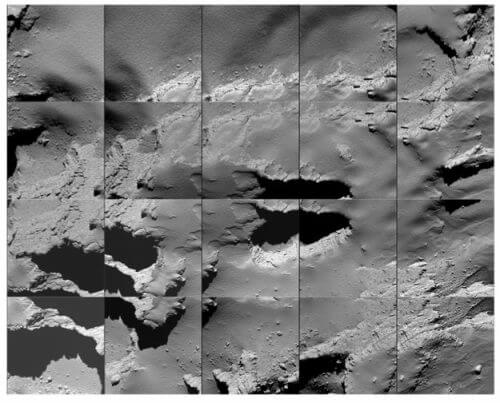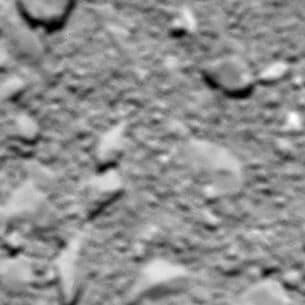The Rosetta mission produced surprising discoveries. One of them is the strange shape of the comet observed during Rosetta's approach to it in July and August 2014. Scientists now believe that the two lobes of the comet formed independently and merged in a low-speed collision in the early days of the solar system.

The European Space Agency's Rosetta mission ended as planned with a controlled crash into the nucleus of the comet it had been studying for over two years.
Confirmation of the end of the mission reached the control center of the European Space Agency in Darmstadt, Germany at 11:19 GMT (14:19 Israel time) with the loss of the signal when Rosetta hit the ground of the comet nucleus 67/p Churyumov Garsimenko.
Rosetta performed its final maneuver last night at 20:50 GMT which brought it into a collision course with the comet from an altitude of about 19 km. Rosetta scientists wanted to direct it to the smaller lobe of the two lobes that give the comet a mallard shape, close to an area containing active craters from which water and dust evaporated as the comet made its way towards the Sun.

The comet from a height of 51 m with a wide-angle camera
The descent gave Rosetta the opportunity to cool the composition of the gas, dust and plasma environment close to the surface, and take high-resolution images.
These pits are of particular interest because they play an important role in the comet's activity. They also provide a unique window into the interior of the celestial body. The information gathered on the descent into this fascinating region was transmitted to Earth before impact. Now it is no longer possible to communicate with the spaceship.
"Rosetta is entering the history books again" says Johann-Dietrich Warner, Director General of the European Space Agency. "Today we celebrate the success of a rule-changing mission that exceeded all our dreams and expectations, and that continues the European Space Agency's legacy of 'beginnings' in comets."
"Thanks to an international effortי Spanning decades, we were able to launch a world-class science laboratory to a comet to study its evolution over time, something no other comet-pursuing mission had attempted. says Alvaro Jimenez, the European Space Agency's scientific director. In fact, Jimenez added, Rosetta was on the drawing board even before the Giotto mission - the European Space Agency's first spacecraft in deep space, which passed by the nucleus of Halley's comet in 1986.
"In addition to the scientific and technical triumph, the amazing journey of Rosetta and its lander Philae also excited the imagination of many people around the world, bringing science to new audiences far beyond the scientific community. The journey moved everyone," adds Mark McCaughrean, the European Space Agency's senior scientific advisor.
Rosetta is now on its sixth orbit around the Sun since its launch in 2004. It traveled nearly 8 billion kilometers and on the way passed by Earth three times and once by Mars to gain momentum that would bring it close to the comet when it was in the orbit of Jupiter. like aן He passed by two asteroids and studied them.
The spacecraft passed 31 months of its journey in a winter year on the most distant part of its journey. It was instructed to wake up in January 2014, and finally began orbiting the comet in August 2014. In November 2014, it sent the Philae lander for the first time in history, which made a bouncy landing and finally found itself in a shadowy area that did not allow it to recharge its batteries. She broadcast what she could until her batteries ran out, but only managed to send the remaining images from that day six months later in a one-time broadcast flash.
Even after the release of Philae, Rosetta continued to track the comet as it approached the Sun and returned to deep space. "We operated in the harsh environment of the comet for 786 days. The spacecraft made several dramatic forays close to its surface, survived several unexpected eruptions from the comet, and twice recovered from its computing transition to 'safe mode,'" says Director of Operations Sylvan Ladio.
"The activity at this final stage has challenged us more than ever before, but Rosetta's own landing on the comet following Philae could be a fitting end to the incredible adventure." said.
The decision to end the mission and smash Rosetta on the comet's surface was made due to the comet and Rosetta moving away beyond Jupiter's orbit. In this area, the energy coming from the sun and absorbed by Rosetta's solar collectors will not allow it to accumulate enough power to operate the spacecraft.
Mission operators also had to contend with an impending month-long period in which the Sun is close to the line of sight between Earth and Rosetta, meaning communication with the spacecraft would become increasingly difficult.
"Thanks to the decision to drop Rosetta onto the comet's surface, we improved the scientific output of the mission in an event that can happen once in the life of a space mission," says mission manager Patrick Martin.
The Rosetta mission produced surprising discoveries. One of them is the strange shape of the comet observed during Rosetta's approach to it in July and August 2014. Scientists now believe that the two lobes of the comet formed independently and merged in a low-speed collision in the early days of the solar system.
The long-term monitoring of the comet's nucleus proved how much the comet's shape affects its 'seasons', and the transfer of dust on its surface, as well as explaining the measured variations in the density and composition of the comet's dormant atmosphere.
One of Rosetta's most important and unexpected findings is in the composition of the gases escaping from the comet's nucleus, including the discovery of molecular oxygen and nitrogen, and water with a different 'taste' than in the Earth's oceans.
The cumulative findings show that the comet was born in a very cold region of the preplanetary nebula over 4.5 billion years ago. Although PJ. SIt appears that impact by comets like 67/P may not have filled the Earth with water as previously thought, but mayן that they brought other elements that were essential to the development of life."
Rosetta did not disappoint, she located the amino acid glycine, which is common in proteins, and phosphorus, a central component of the DNA envelopes of the cells. Many organic compounds have also been discovered both by Rosetta from orbit and by Philae on the surface.
"This is a bitter end. Still, the mechanics of the solar system were simply against us: Rosetta's fate was decided long ago. But her excellent achievements will remain for future generations and will be used by the next generation of young scientists and engineers around the world." Martin said, adding that while the operational part of the Rosetta mission ended today, the analysis of the scientific data will continue for many years."
The comet study at Tel Aviv University
The Rosetta spacecraft project and the Philae lander is the most complex project for comet research, a flagship program of the European Agency. The American space agency NASA also donated a number of measuring devices. Researchers from all over the world are processing the measurement results obtained and also in the Comet Laboratory in the Department of Earth Sciences under the authority of Prof. Akiva Bar-Nun and the team of researchers Dr. Diana Lauper and PhD student Adi Nino Greenberg, research is being conducted according to the results received so far in the Comet Ice Simulation Laboratory. Prof. Akiva Bar-Nun is one of the planners of the mission and part of the research team (PI) In a project as a member of the group of the University of Bern in Switzerland to test the composition of the gases released from the comet. The Rosetta spacecraft was not designed for a landing mission and the mission engineers decided to crash it.
Comets are small frozen bodies in the solar system composed of water ice, dust, organic substances and various gases, mainly carbon dioxide and carbon monoxide. When a comet approaches the Sun, a tail of glowing gas and dust is formed millions of kilometers long. Comets contain materials that have been preserved since the formation of the solar system, therefore the measurements of the Rosetta mission will contribute to understanding the processes that brought water, organic materials and gases to Earth.
The Rosetta spacecraft was launched from Earth in March 2004 and on September 10, 2014 entered the coffee orbit around the comet Churyumov-Grasimenko which is about 4 kilometers in size. On November 12, 2014, Rosetta's lander, Pillai, landed on the comet's surface, but unfortunately, Pillai landed on its side in a dark spot, but still managed to take measurements and transmit them to Earth for about 57 hours. On September 5 of this year, the researchers were able to identify the lander on the bumpy surface of the comet (photo 4).
Breakthrough discoveries
During the two years that the Rosetta spacecraft has been following the comet, a huge number of measurements have been made. For example, over 1.7 million vehicle measurements were collected in which 34 new molecules out of 60 were identified.
"Among the important discoveries of the mission: measuring the composition of water, which is different from its composition on Earth; Discovery for the first time of the noble gases argon, krypton and xenon together with nitrogen and oxygen indicating the formation of the comet at a low temperature of about 30 degrees Kelvin, as also measured in our laboratories; The discovery of organic substances and especially the discovery of the amino acid glycine, which is found in proteins and phosphorus, an element found in DNA, i.e. substances related to the appearance of life on earth. The activity of the comet in its orbit around the sun, changes on the surface and the creation of craters as a result of the eruptions were also measured. The results of measuring the strength of the soil on the comet and its density also match the measurements obtained at the distances we conducted at the Comet Research Laboratory."
